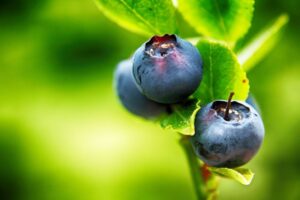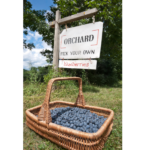When Are Blueberries In Season? Understanding Their Peak Harvest Time
As someone passionate about fresh produce, I’m always eager to share insights on the best times to enjoy one of nature’s little gems: blueberries. The season for blueberries is influenced by the climate and geographical location, which means there isn’t a one-size-fits-all answer.US blueberry season runs from April to late September, varying by region.

West Coast blueberries arrive in March; Northeast fans may wait until late July. Various ripening times extend blueberry season, offering a longer period to savor the berries. However, for the freshest and most flavorful blueberries, it’s key to focus on the peak months for your particular area.
Proper selection and storage of blueberries are crucial for optimal enjoyment, just like timing. The perfect blueberry should be firm, have a uniform hue, and be eaten shortly after purchase for optimal freshness. Preserve your berries effectively to relish the taste of summer beyond the season.
Key Takeaways
- Blueberry seasons vary across the US, but generally run from April to late September.
- It’s important to know your region’s peak blueberry months for the freshest fruit.
- Proper selection, storage, and preservation extend enjoyment beyond the natural season.
Understanding Blueberry Seasonality
The key to enjoying fresh blueberries is knowing when they are in season. This period varies across different regions and is heavily influenced by local climate conditions.
Why Blueberries Have a Season
I’ve found that blueberries aren’t just a summer treat; their seasonality is dictated by their growth cycle and local environmental factors. For blueberries, this cycle begins with springtime flowering and culminates in fruit ripening over late spring into summer. The type of blueberry cultivar also plays a role in when the berries ripen, with certain varieties maturing earlier or later in the season.
The Effect of Climate on Blueberries
Climate is pivotal in determining the blueberry season. Warmer regions often see an earlier arrival of blueberries, sometimes as soon as April, due to milder winters and an early onset of spring warmth. On the flip side, colder climates can delay blueberry ripening until later in the summer. Extreme weather conditions, such as unseasonably cold snaps or heat waves, can shift the timeline as well, sometimes leading to innovations like off-season flowering to extend production times.
Recognizing how climate shapes the blueberry season helps me anticipate when these delicious berries will be ready for picking and savor them at their peak of freshness.
Identifying Peak Blueberry Months

In my exploration of blueberry harvest times, I’ve noted that the peak months for harvesting these berries can significantly affect their flavor and availability. The specific timing largely depends on regional climates and the variety of blueberry plants being cultivated.
Key Months for Peak Flavor
For blueberry enthusiasts seeking the best taste experience, May through August is a crucial period. During this span, blueberries reach their optimal ripeness, delivering that perfect blend of sweetness and slight tartness we all relish. The warm summer months are particularly pivotal, with August often heralding the tail end of the crop’s peak condition in many areas.
Regional Differences in Blueberry Season
The peak months for blueberry season exhibit notable regional variations across North America. In warmer climates such as Florida, blueberry harvest can begin as early as April and extend through May, whereas in states like Michigan and Maine, where the climate is cooler, the season may peak a bit later, typically in July. Out on the West Coast, California often sees its blueberry season starting around March, with prime picking lasting until June.
- Florida: April – May
- Michigan: July
- Maine: July
- California: March – June
Understanding these regional differences can guide you to the best times to find fresh, flavorful blueberries in your area, ensuring you’re enjoying these delectable fruits when they’re truly at their best.
Selecting and Picking Ripe Blueberries

When I look for fresh blueberries to pick, I focus on ensuring they’ve achieved full ripeness and have the right size, which are critical factors for flavor and texture.
How to Pick the Perfect Blueberry
When I’m in the field or the store, I search for berries that have a uniform deep-blue hue with a slight silvery frost. This coloring indicates they are ready for picking. I ensure the blueberries I pick are firm to the touch, not shriveled or soft. It’s important to note that blueberries do not continue to ripen significantly after harvest, so what I see is what I get.
For the best experience:
- Use a gentle hand: I carefully roll the blueberry between my thumb and the palm to avoid bruising.
- Look for the right size: Typically, a larger blueberry signifies maturity, but I always verify it’s not just size but also a deep color that suggests readiness.
- Check the stem: If it’s fresh, the stem end of a blueberry has a bright green color.
Understanding Ripeness and Size
The size of a blueberry is often indicative of its variety rather than ripeness alone, but once I find blueberries that are large and have achieved a uniformly dark blue color, I consider them ripe. Over my years of selecting blueberries, I’ve learned that the best ones come off the bush with minimal effort—if they’re ripe, they should fall into my hand with a gentle tug. If I have to pull hard, they’re likely not ready. It’s as simple as that.
When assessing for ripeness:
- Look and feel: I check for a firm texture as softness can be a sign of over-ripening.
- Size comparison: I sometimes will compare to other blueberries in the vicinity, understanding that while size can vary, it should be proportionate to the typical size for that blueberry type.
Storing and Preserving Fresh Blueberries
When I get my hands on fresh blueberries, my priority is to maintain their quality and extend their enjoyment for as long as possible through effective storage methods.
Tips for Refrigeration and Freezing
For Refrigeration: I make sure to store my fresh blueberries in the refrigerator without washing them first; moisture can encourage mold. I place the blueberries in a shallow container, loosely cover them with a lid or plastic wrap, and refrigerate immediately. This method keeps them fresh for up to a week. You can learn more about the importance of avoiding deep containers to prevent bruising from Rural Sprout.
For Freezing: To freeze the blueberries, I spread them out on a baking sheet in a single layer to keep them from sticking together. After freezing them for a few hours, I transfer the frozen blueberries into airtight freezer bags or containers. This maintains their quality for several months, making it a convenient long-term storage solution. Detailed freezing instructions can be found on Allrecipes.
Extending Freshness Beyond Season
Preserving blueberries efficiently allows me to enjoy their fresh flavor even when they’re not in season. To further extend their longevity, I sometimes use a paper towel at the bottom of the storage container to absorb any excess moisture when refrigerating. As for freezing, labeling the bags with the date ensures I keep track of their shelf-life. For step-by-step guidance, EatingWell provides a thorough look at prolonging freshness.
Incorporating Blueberries into Your Diet

When blueberries are in season, it opens a spectrum of opportunities for enhancing your diet with a burst of flavor and nutrition. Opting for these sumptuous fruits allows for a creative culinary experience while reaping their health rewards.
Health Benefits of Blueberries
Blueberries, favored for their delicious taste, are more than just a sweet addition to my diet; they are a powerhouse of nutrition. They are renowned for their high levels of antioxidants which protect cells from damage. In fact, studies have identified blueberries as packed with valuable constituents, reinforcing their title as a significant fruit in the nutrition world. Including blueberries in my meals may also offer benefits due to their various functional ingredients. Moreover, it’s reassuring to know that blueberry pollination and fruit quality are carefully researched, considering factors like pesticide risks that can affect both bees and the fruits I consume.
Creative Blueberry Recipes
In my kitchen, I find that blueberries’ versatility makes them a fantastic ingredient across a variety of dishes. I enjoy incorporating them into recipes from smoothies for a hydrating and nutritious drink to innovative desserts that please anyone with a sweet tooth. Here’s a simple way to enjoy blueberries:
- Morning Boost Smoothie:
- 1 cup of blueberries
- 1 banana
- 1/2 cup of water or almond milk
- A spoonful of honey (optional)
I blend these ingredients until smooth, which makes an excellent start to my day. For culinary enthusiasts looking to explore further, blueberries can also be a part of savory dishes, adding a unique twist to salads or as part of a sauce paired with proteins. The key to enjoying blueberries in meals lies in embracing a variety and not shying away from experimentation.
Frequently Asked Questions
In this section, I’ll address some of the most common questions regarding blueberry seasonality, including when they are typically available, variations by location, peak season timing, their global cultivation, and factors influencing their market price.
What months typically mark blueberry season in various regions?
In the United States, blueberry season varies by region. For instance, in California, the blueberries are typically harvested from March to June, while the Northeast enjoys a later season stretching from late July to September. In the Southeast, you can find blueberries from April to May, and the Midwest and Rocky Mountains usually have blueberries from mid-July to early September.
How does blueberry seasonal availability vary by state?
Each state may experience slight differences in blueberry season due to local climate and variety selection. For example, in zones 9 and 10, you can expect blueberries to ripen as early as April through June, while in the Southeast, blueberry season generally falls in April and May.
Which season is considered peak blueberry season?
Peak blueberry season in the United States usually occurs from late May through early September, hitting its zenith during the warmest summer months when conditions are optimal for blueberry production.
In which countries are blueberries predominantly grown and harvested?
Blueberries are predominantly grown in North America, with the United States leading as one of the largest producers. Other significant producers include Canada, Mexico, and countries in South America, such as Chile and Peru, as well as in Europe where countries like Poland and Germany have substantial blueberry farming.
Can blueberries be purchased outside of their natural growing season?
Yes, due to global trade, blueberries can be purchased year-round. During off-season periods in one hemisphere, blueberries often are imported from regions where they are in season, ensuring availability in markets and grocery stores.
What factors contribute to the variation in blueberry prices throughout the year?
Availability and demand heavily influence blueberry prices. Prices may rise during the local off-season due to the costs associated with importing. Conversely, prices tend to decrease during the local peak season when supply is abundant. Weather and crop yields also play crucial roles in determining the market price.


 Previous Post
Previous Post Next Post
Next Post